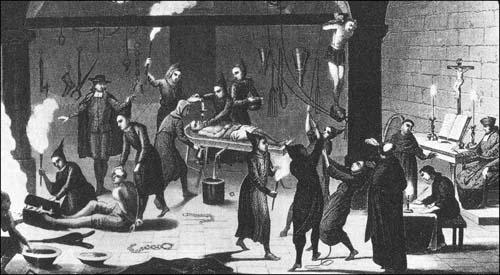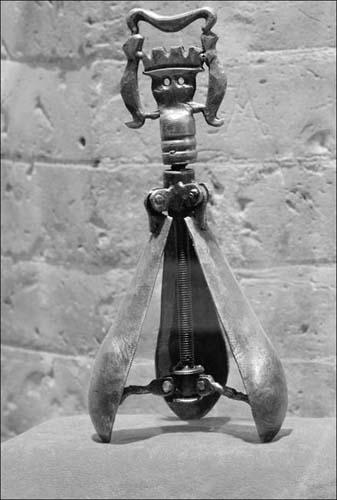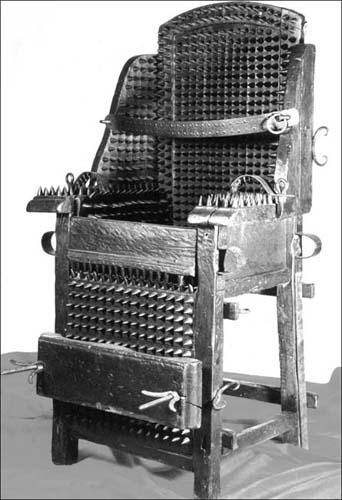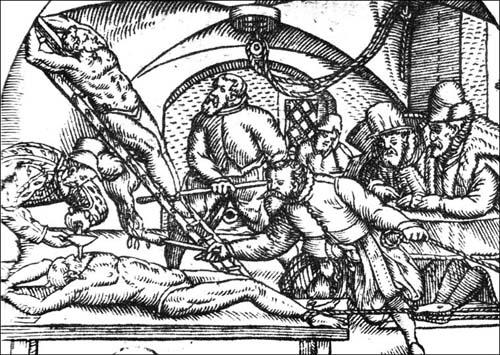The Big Book of Pain: Torture & Punishment Through History (18 page)
Read The Big Book of Pain: Torture & Punishment Through History Online
Authors: Daniel Diehl

During the High Middle ages, Spain was a fractured, polyglot society peppered with numerous small states, competing monarchs and peoples of many races and religions. Beginning in the early eighth century, much of Spain had come under the control of the Moors – Moroccans who followed the Islamic faith. Immediately, the Christian Spanish began to fight back, but it was not until 1492, when the city of Granada was reclaimed, that the Moors were finally defeated. During their more than seven centuries of occupation, the Moors had welcomed a large influx of Jews into their Spanish territories, adding to the complex cultural mix of the country. As the Moors were slowly driven from power they and the Jewish population were either expelled or forced to convert to Christianity. Naturally there was always the sneaking fear that they only pretended to convert and were really practicing their various religions in secret. Anxious to complete the process of cleansing their country of all those ‘foreigners’, as early as 1478 dual-monarchs Ferdinand and Isabella (the same ones who funded Christopher Columbus) asked Pope Sixtus IV to allow them to establish their own, home-grown, version of the Inquisition. The suggestion was probably Isabella’s and had most likely originated with her personal confessor, a fanatically xenophobic Dominican monk named Thomas de Torquemada. Bowing to the pious monarchs’ request, and the recommendations of Torquemada and the Archbishop of Seville, the Pope issued the necessary Papal Bull. The Spanish Inquisition had commenced and Thomas de Torquemada was placed at its head.

Here we see various tortures as employed by the Inquisition for uncovering ‘heretical conspiracies’. From left to right we can see a victim being burned or branded while subjected to the stocks, another victim in the center enduring the torture of the funnel (note how the ‘bed’ has been specifically designed to drain and recycle the water which tortures him). Then we see a poor wretch undergoing the torture of the pulley. And to the right we see the grand Inquisitor with his clerk dutifully recording the proceedings.
Although the primary targets for this long-lasting reign of terror were the
Conversos
and
Moriscos
(Jews and Islamic Moors respectively) who had converted to Christianity, included on the ‘enemies list’ were unconverted Jews and Moors, Freemasons, Catholic heretics and members of emerging non-Catholic Christian sects grouped together under the catch-all title ‘Protestants’. To increase the efficiency of the persecution, the populace was encouraged to cooperate with the authorities by denouncing suspects, be they neighbours, friends or family members. Once a person had been denounced the procedure never varied. The evidence, no matter how slim, was examined by an inquisitorial panel who would decide if there was sufficient evidence for an arrest … there almost invariably was. To keep the accusers conveniently free from public condemnation or having to explain their accusations, their names, like every other step in the inquisitorial process, were kept secret.
When an arrest order had been issued, a group of Inquisitors, priests, commissioners and heavily armed soldiers went to the suspect’s house – always in the middle of the night. If the suspect resisted arrest in any way they were bound and gagged by having a metal, pear-shaped object inserted into their mouth. A small crank on the small end of the ‘pear’ was turned, expanding the device until it wrenched open the jaw, often breaking teeth and sometimes dislocating the jawbone. Once the suspect was safely locked in an inquisitorial dungeon, their property was confiscated on the grounds that it would be used to pay for their upkeep in prison and the cost of their questioning and trial.

Without going into too much graphic detail, these devices were inserted into the mouth, vagina or anus and then opened wider and wider to stretch and tear the tissues (or in the case of the mouth, breaking the teeth and jaw). We have inspected several examples of this type and all have invariably been extremely well made and almost artistic in their construction. These are not mere implements of pain from some dark age torture chamber. The individuals who had these constructed were men who took pride and pleasure in inflicting torture upon their victims.
The accused were, of course, free to confess their guilt prior to being tortured but since they often had no idea what they had been accused of, it was nearly impossible either to confess or deny the charges and attempt to defend themselves. Following the initial questioning, the victim was hauled to an underground room, often draped in black, where an official inquisitor, along with an ‘inspector’ and a secretary were seated at a table at one end of the room. Also present was a torture master dressed all in black, with only his eyes exposed. Nearby lay an array of the diabolical tools of his trade. What all those present knew that the prisoner did not, was that there were five distinct phases of torture. First, the prisoner was threatened with torture; second, he was shown the implements of torture; third, he was stripped and blindfolded; fourth, he was tortured and, finally, given another chance to confess. If they still insisted on their innocence the fourth and fifth steps would be repeated indefinitely, until he or she either talked or died. This process was administered without distinction to age, sex or social condition and the methods of torture used were completely random, being limited only by the whim of the inquisitor, the inspector and the type of equipment available.
Even when elaborate torture equipment was lacking, the inquisitor was happy to make do with those old standbys, the whip and a length of rope. Just how common inquisitional floggings were is revealed in the writings of a Portuguese chronicler:
Should anyone commit a fault he is flogged in a most cruel manner. They strip him naked and lay him on the ground with his face downward, and in this position he is held by several men while others flog him most unmercifully with cords stiffened by being dipped in melted pitch, which brings away flesh at every stroke, until the back is one large ulcer.
In one such case, a fourteen-year-old boy was simply whipped to death for indeterminate reasons. In another instance, a woman was savagely whipped for having been heard to say: ‘I do not know whether the pope is a man or a woman, but I hear wonderful things of him every day …’ Six days later she died from her wounds. When a Portuguese jeweller was arrested on suspicion of being a Freemason, he was subjected to an amazing array of tortures. The following is his own account of the experience:
[After] strip[ing] me naked … they put round my neck an iron collar … then they fixed a ring to each foot, and … they stretched my limbs with all their might. They next tied two ropes … which were the size of one’s little finger … round each arm and two round each thigh, which ropes passed through holes in a scaffold; and were all drawn tight at the same time by four men.

Here we see the ‘inquisition chair’ (sometimes referred to as the ‘witches chair’ or the ‘interrogation chair’ or even simply as ‘the throne’). Its function should be clear from the image. Consider first, however, that it is made to appear frightening – as the first stage of torture was to show the victim the instruments of their destruction in the hope that the sight alone might persuade them to confess. While it would have undoubtedly been a painful place to sit, the real agony of the device lies in the spiked board which would be tightened down on the victims thighs (above the seat) and across their shins (on the front). Note also the sockets on the side of the chair through which bars could be threaded so that the entire piece could be transported like a sedan chair – perhaps even displayed to the populace. Naturally once the victim was strapped and clamped into the seat other even more diabolical tortures could (and probably would) be applied to them.
[The ropes] pierced through my flesh quite to the bone, making the blood gush … Finding that the tortures … could not extort any discovery from me … six weeks after [they] expos[ed] me to another kind of torture. They made me stretch my arms in such a manner that the palms of my hands were turned outward; when by the help of a rope that fastened them together at the wrists, which they turned by an engine, they drew them nearer to one another behind [me] in such a manner that the back of each hand touched … whereby my shoulders were dislocated and blood issued from my mouth.
When Jewish physician, Isaac Orobio was arrested, he lingered for three years in an inquisitional dungeon before they got around to questioning him. When they did, Orobio first had his thumbs tied together with fine cord which was pulled so tight that blood spurted from beneath his thumbnails. Having thus gotten the poor man’s attention, the torturers next slammed him against a wall and sat him on a narrow bench. Attached to the wall were several pulleys with ropes hanging from them. His arms, hands, legs and feet were thrust through the ropes, which were then pulled as tight as possible; the bench was then pulled from beneath him, leaving the weight of Orobio’s body suspended by the ropes alone.

Here we see two men being racked. One of them is being racked by the ladder (which we shall discuss later in the book) and the other is being racked on a table while being subjected to the torture of the funnel. A thorough description of the use of this commonplace, yet devious, device can be found in the main body of the text. The torturer operating the rack pulley seems poised to burn the victim’s stomach with a flaming torch. Also note the pulley in the centre of the room which awaits these two unfortunate souls should their current torments not elicit the desired results.
When an Englishman named William Lithgow was arrested on suspicion of being a spy, he was subjected to one of the Spanish Inquisition’s most popular tortures in which the victim had their mouth forced open and a funnel pushed down their throat. Water was then poured into the funnel until the stomach nearly burst, the throat filled and water gushed from their mouth and nose. In this condition Lithgow was prevented from vomiting by having a noose tied around his throat; then he was rolled back and forth across the floor of the dungeon. When he was nearly unconscious, ropes were tied around his big toes and he was hoisted, feet first, into the air. At his point the rope was removed from his throat and he was allowed to vomit out the water while hanging upside down. He was then manacled and returned to his cell.
